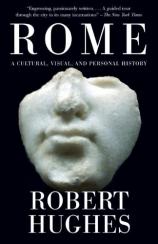Rome: A Cultural, Visual, and Personal History
Review
Rome: A Cultural, Visual, and Personal History
For centuries, students around the world --- whether studying mythology in elementary school, oratory and history in high school, or philosophy and ancient religion in college --- have come upon Rome. And for centuries, the curious, the romantic, the faithful and the adventurous have come to the city to be inspired, educated and awed. Art critic Robert Hughes was no different, drawn to this powerful civilization and remarkable city as a young man. He first traveled there from his native Australia in 1959 and was enthralled.
"Spanning thousands of years and addressing vast topics, ROME is a weighty read without ever getting too bogged down and a serious read that manages to be fun."
Now over 50 years later, he returns to the city with a sharp eye and even sharper pen in ROME: A Cultural, Visual, and Personal History. This elegant work of nonfiction is not quite history and not focused only on the visual arts, though art and history play a huge role in it. Instead, it is a sweeping exploration of Rome as more than just a city. Here, Rome is an idea, a creative energy as well as the geographic place that has bred or drawn some of the most influential minds in western civilization.
Hughes starts at the beginning, though, as he admits that “nobody can say when Rome began.” Perhaps the city was founded by Romulus in the eighth-century BCE or perhaps earlier. In any case, by the second century BCE, the Romans themselves had lost the foundation of the city to the cloudiness of the past. What is clear is that when it emerges, Rome adopts the ideas of other cultures like the Etruscan and the Greek, and at the same time builds on those ideas, mingling them with their own, to create a civilization bound for greatness. Early on, the Romans proved to be skilled administrators, military men and politicians. The organizational and technological talents eventually allowed them the luxury to create fantastic works of art, the art that countless tourists flood the city to see every year.
Hughes introduces the Caesars and other early figures without resorting to a dull textbook tone. In fact, his narrative is so charming, so smart and at moments so funny that it makes for an entertaining and illuminating read. Even when explaining “Senatus Populusque Romanus,” the work of the second-century jurist Ulpian or the poetry of Publius Ovidius Naso, Hughes's writing remains mostly fresh and accessible. At times the narrative gets a tad muddied, especially as the parade of emperors, orators and early Christian saints go marching quickly by. But just as it seems Hughes is about to lose control, a next section will be better written and perhaps more meticulously researched.
ROME doesn't just present the city's ancient past; here we meet medieval popes, Renaissance painters and modernist filmmakers. Raphael and Michelangelo are expected figures, as is Mussolini. Spartacus is here as well as the Medicis. But Hughes finds space for Lollia Paulina (the third wife of Caligula), futurist artist Filippo Marinetti and sculptor Giacomo Zoffoli, not to mention the scores of artists, writers and thinkers who came to Rome for a period of time or to make it their home.
Spanning thousands of years and addressing vast topics, ROME is a weighty read without ever getting too bogged down and a serious read that manages to be fun. The history and culture of Rome is a fascinating subject, and in Hughes's capable hands it is even more so. Because it is not a traditional history book but instead a book of ideas about the ideas of Rome, the pace and choice of subjects may feel strange to some. But in the end, this is Hughes's understanding of Rome. Read that way, it makes for a challenging and highly recommended book.
Reviewed by Sarah Rachel Egelman on December 1, 2011
Rome: A Cultural, Visual, and Personal History
- Publication Date: October 30, 2012
- Genres: History, Nonfiction
- Paperback: 512 pages
- Publisher: Vintage
- ISBN-10: 0375711686
- ISBN-13: 9780375711688





